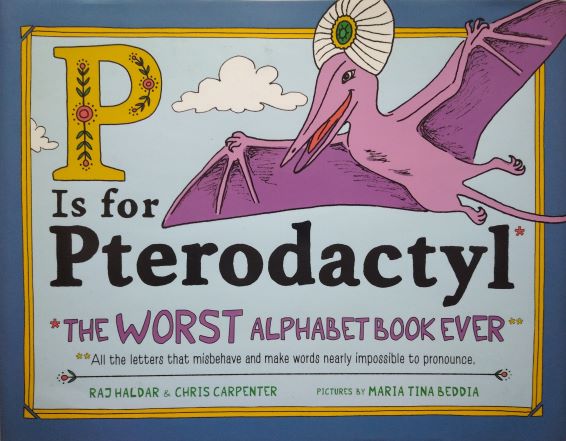
What a wonderful book this is, The Worst Alphabet Book Ever, by Raj Haldar and Chris Carpenter. In a way, it has inspired this post here, on all things related to homework for pre-primary EFL students.
Mine is a very messy alphabet, with some letters in, some letters missing, all of them in a very un-alphabetical order…
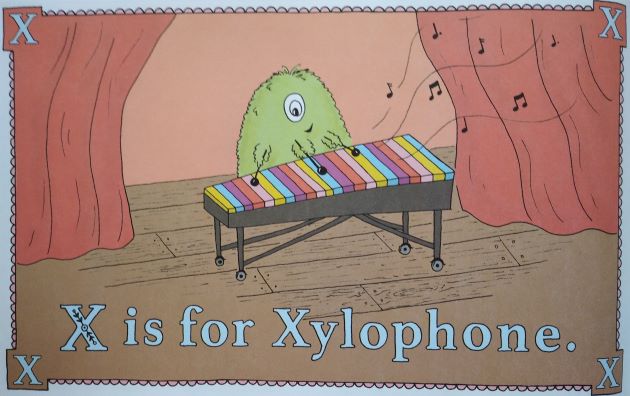
S is for ‘Should we even think of setting homework for preschoolers?’
Some of the arguments against:
- Kids are too young
- It is too much pressure, too early. They will grow up, start school and then they will have to really learn what it means to be a student.
- Kids forget to do the homework.
- Parents forget to do the homework.
- Parents may not speak English well enough to help with the homework task.
- Parents work and are essentially too busy to deal with the homework tasks.
Some of the arguments for:
- We are teaching the kids English but we are also teaching them how to be a student. Doing the homework and taking responsibility is a part of that process.
- It has to be the homework task that is appropriate for the students’ age (2 – 6 years old) and level of English (pre-A1) so also something that non-English speaking parents will be able to do and something that will not take a lot of time
- Certain procedures for setting the homework and checking the homework should apply to ensure that the tasks are not a hassle for the parents or the children
- Homework is a wonderful way of creating a link between different lessons
So the short answer to the question in the heading would be ‘Yes, we definitely should’.
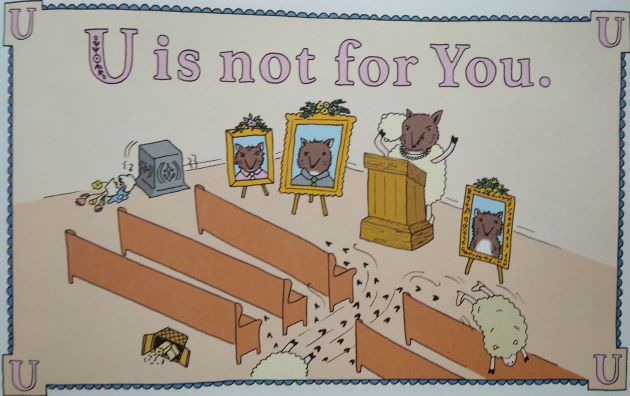
E is for the extended exposure and R is for results
This is one more argument in favour of the VYL homework, so important in fact that it is going to have its own paragraph here.
Usually, pre-primary students who learn English as a foreign language have a very limited exposure to the language as they come to class twice a week for 45 minutes or, in some cases, for only 45 minutes once a week. That is not a lot but it is enough to get good results if the time in class is spent well. Or, if there is an opportunity to extend this English exposure time by homework tasks.
In practice, in might mean only the additional five or ten minutes or fifteen minutes per week but it will be the important link that will provide some additional practice between the lessons, which will be very beneficial for the children and it will help to recycle and keep up the language from Tuesday to Thursday and, even more importantly, from Thursday to Tuesday.
As it happens, a few years ago, me and my colleague-teacher, Anya (hello Anya!), we had a chance to be a part of a very informal and very small scale classroom research or an accidental experiment. We both worked with the same levels onsite (at one of our IH schools in Moscow) and, at the same time, offsite (at one of the kindergartens). All the kids were amazing, very bright and a pleasure to teach. They had the same teachers and they were following the same programme and yet, we realised that the onsite students were making more progress. We tried to analyse the situation and the only difference between the groups that we could put a finger on was the fact that our offsite groups were not getting any homework, according to the arrangements with the client.
Then, there were my other groups, a few years ago, that all of a sudden started to make lots of progress and, surprisingly enough, we did not have to devote so much time to drilling and practising the new vocabulary, right after it was introduced.
Normally, the first two lessons with the new material were filled with a lot basic games whose aim was to provide the exposure and the controlled practice before we would move onto more complex vocabulary games and introducing structures. Until, that is, I noticed that all this drilling was not necessary and, in most cases, already in the second lesson the children were using the new vocabulary with a lot of confidence. What it did look like in class, of course, were my students’ faces quickly losing interest in ‘just’ repeating the words with voices and emotions and, even, random comments (or, shall we say, feedback) muttered, here and there, ‘Да, мы уже все это знаем...’ (‘We already know all that...’)
I would never complain about that, we could move on and do the more interesting and challenging things but it took me a while that it was connected to the additional practice opportunities that the parents were providing at home. Just because they wanted to.
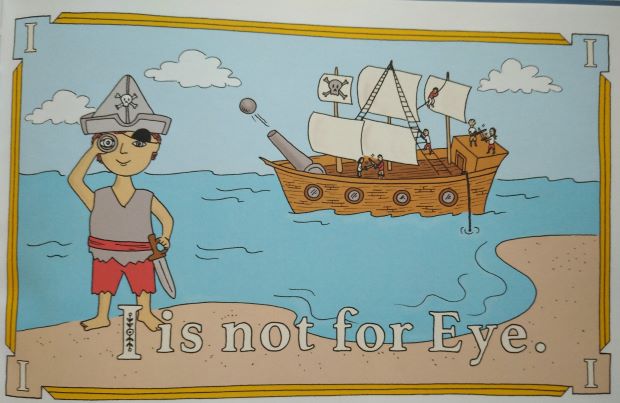
P is for the parents
It is not a secret that in case of all the young learners or non-adult groups, the parents are the third party involved in the process and, one way or another, they will have to be included because, really, they are our clients, not the students themsevels. This is particularly true in case of the pre-school groups, mainly because children are very young and if we want to make the learning process effective, with homework or without it, we will be dealing with parents, too. Even more so, we need parents to make it all work.
Parents always want the best for their children but many of them are also taking their first steps in the EFL world, this time through their children. They might have had different previous learning experience (their own or of their kids’), they might have different expectations and aims that might not always coincide with ours, with our previous teaching experience or with our school’s policy. That means that we cannot take things for granted and that we should always talk to the parents, to explain what we do and why we do it. That applies to the homework tasks, too.
Some parents might really not be able to spend time with their children, some might choose to spend the time they have in other ways, not working on the English homework and we should accept and respect that. However, there are also parents for whom the English homework will not be so much of a burden but rather an opportunity to do something together in English. We can help them by showing them what can be done at home and the actual homework task is the first step here.

N is for nuts and bolts
Here are some things to take into consideration
- The homework should be short. Our students are still two or three or five and will not be able to remain seated for a long period of time, in class or at home.
- It should be easy to complete, too. The students are still two or three or five and tasks that are very complex cognitively will not be appropriate for them.
- However, the fact that the task looks like a simple colouring page (see below) does not mean that it is just colouring because the actual physical task will be connected with the language produced that is presented and practised in class with the teacher, practised at home with the parents and then practised again, with the teacher, during the homework check in the following lesson.
- Ideally, the homework task should be consistent, in form and in content, with the focused task completed in class. This way, we do not only provide additional practice of the vocabulary and structures that we currently work on but we also ensure that the students will know how to complete the task because the instructions are the same, for the focused task and for the homework task. Of course, that is not always possible but it is a good aim to set for yourself while lesson planning.
- For that reason, the longer I work, the more convinced I become that in an ideal set-up, I would rather work with a coursebook only, without any activity book whatsoever, in order to give myself the flexibility to match and to better combine the programme, the focused task and the homework task. This is, of course, only my very subjective view and I am aware of the fact that it would not be everyone’s choice.
- The task should be set in class, with the students. After all, these are the ones who are learning to be responsible for the task. For the teacher and the students this is, yet another opportunity for practice. The teacher can bring another copy of the handout or the book and do the task together with the students.
- The homework task should be explained to the parents, too, because, they will have to remember to take the task out and to complete it before the following lesson. There are different ways of doing it. The teacher can explain the task after the lesson, alone or with the help of the students, the administration of the school can be asked for help, too. Some teachers like to leave the notes about the homework on the door of the classroom and, nowadays, we all have the whatsapp groups which we can use to communicate with the parents, too.
- The homework checking is a part of the routine and another opportunity to practise the language and to talk to students, one on one, as they walk into the classroom (more about the line-up routines here). In the past, I used to reward my students with stickers for the homework but I stopped doing that when I realised that not everyone does or brings their homework and that is precisely because mum or dad or granny forgot…Now, I only acknowledge the hard work with smileys, suns, flowers, ‘Fantastic!’ and ‘Excellent’ and I keep a spare handout, my homework or any visual in order to be able to have a little chat also with those students who are without a homework task on the day.
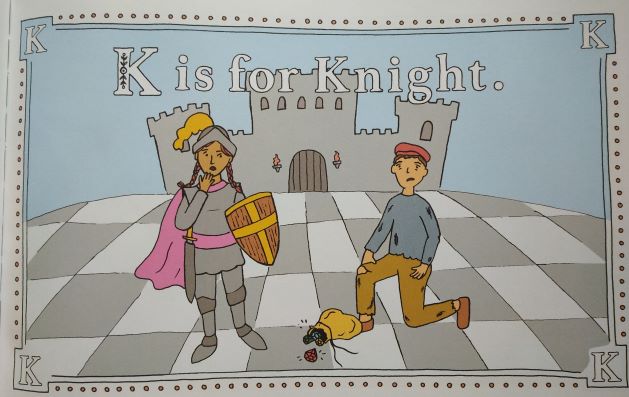
B is for the basic homework tasks
Here are some of the staple food tasks that work well as homework tasks. All of these were created using the miro board. These are not actual handouts but only sample tasks in each type.
a) colouring: task: students colour the objects and produce simple sentences ie ‘The apple is green’ or ‘It’s a green apple). This kind of a task is especially appropriate after the new vocabulary has been introduced and colours can and should be revised throughout the course.
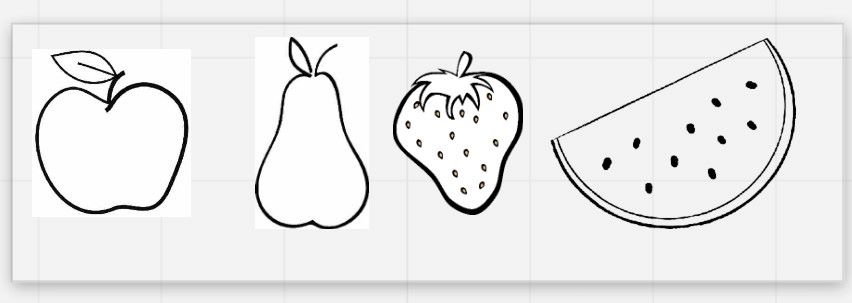
*****
b) drill: task: students look at the the sequence of words, name them, using a single word or a sentence and make a decision what should be the final word. This is also a task appropriate in the beginning of the unit. Here, some students might choose to colour the picture but that is not obligatory.
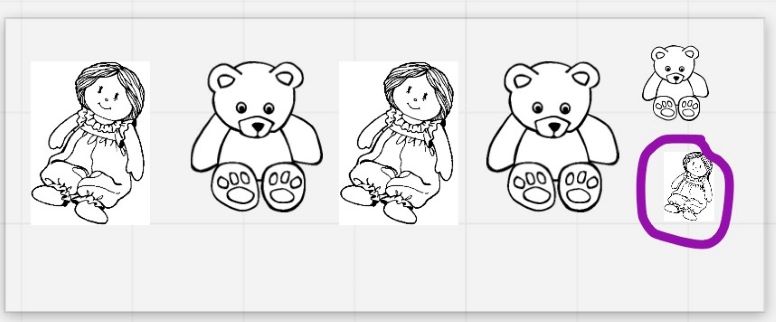
*****
c) odd one out: task: students name all the objects in the sequence and decide which one does not match the others. We usually use very simple langauge here for example: Goodbye, cat.

*****
d) matching: task: students look for the same objects in both columns and connect them with a line. This is also a task more appropriate for the beginning of the unit and for younger students, too. The older students can complete it, too, but in their case it would be a good idea to encourage the kids to produce a full sentence.
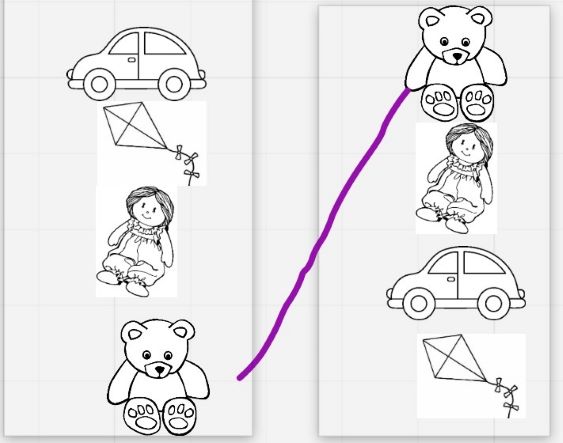
*****
e) finish the sentece: task: students try to build simple sentences by naming the elements of it represented by visuals or symbols and by choosing one of the elements.

*****
f) categorise: task: depending on the language, students can categorise the objects into those that they like or don’t like, big or small, animals that can fly or swim or even words beginning with the same sound if you have started working on developing literacy skills. They can either colour or circle different categories with different colours, at the same time producing the target language.
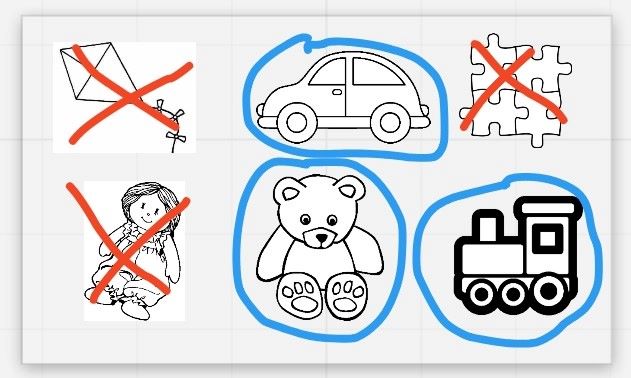
*****
g) count: task: students look at the picture and count all the apples, bananas, kiwis and nuts, they write the number.
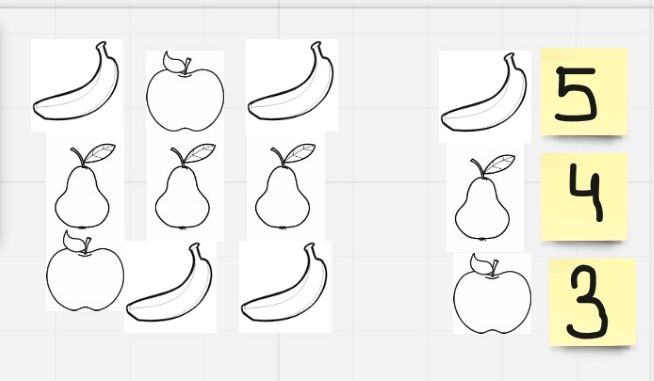
*****
h) maze: task: students trace different lines in order to produce the required sentence, for example ‘I’ve got a doll’ and similar. Again, thanks to the fact that all elements of the sentence are represented visually, an activity like that is going to support maximising production, here full sentences.

*****
i) collage: task: in class, students make sentences about mum, dad, grandma (my mummy likes apples) glueing simple pictures in the appropriate part of the handout. All the leftover pictures are given out as homework. Students glue them onto the handout and produce similar sentences but now about brother / sister, grandpa or friends.
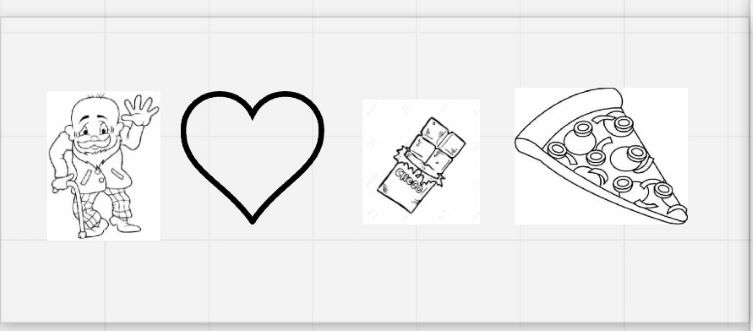
A is for the alternatives
Normally, the homework task is set as a handout (or in the activity book) but the pandemic and the lockdown of 2020 has changed everyone’s way of looking at homework and, fortunately or unfortunately, it has closed some doors but it has opened some others. During the lockdown, not all the studnets had access to a printer so sending out homework for the parents to print and complete was not always possible. What is more, not all the students even had coursebooks and so these could not always be used as the basis for homework tasks.
W is for Wordwall
This website has been a real revelation and a milestone in tasks for age groups of students but especially for my pre-primary studnets. Wordwall is available for everyone and free in its basic version. Anyone can register and gain access to all the tasks and games that have been created by the community and made public. These games can be used in class and shared with the parents to play on any device available at home. Another advantage is that each of the tasks or games is available in a few different formats (or ‘templates) which means that the parents (or the teachers) can still practise the same set of vocabulary or structures but in a slightly different game.
If you are willing to invest a small sum of money, you can choose your own plan and start creating your own activities to match the programme or the curriculum of your group or school, too.
Here are some examples of the games that I have created for my pre-primary students
a) Let’s count, created for the students who were in the beginning of level 1
b) Categorising, created for level 2 students (farm animals which can fly, swim, run, jump)
c) Tell me about this picture, created for my level 3 students to practise opposite adjectives.
All of these we played in class, first and then the same or a similar task was shared with the parents.
L is for homemade listening tasks
These are lightly more complex but a real lockdown revelation for my primary and pre-primary classes. You can read more about them here.
Happy teaching!
P.S. All the samples of activities were created using the images on Miro and all the in-text photos come from the same wonderful book, P is for Pterodactyl, The Worst Alphabet Book Ever by Raj Haldar and Chris Carpenter and illustrations by Maria Tina Beddia from Sourcebook Jabberwocky, which by the way can be (and will be) used with my teens. More on that later:-)
*** This post was based on the talk I gave at the 2020 IH YL Conference.
P.S. A request!
It is very simple.
I would like to know a tiny little bit more about my readers. There are so many of you, popping in here, again and again, and the numbers of visitors and visits are going up and make my heart sweel with joy. But I realised I don’t know anything about my readers and I would love to know, a tiny little bit more.
Hence the survey.